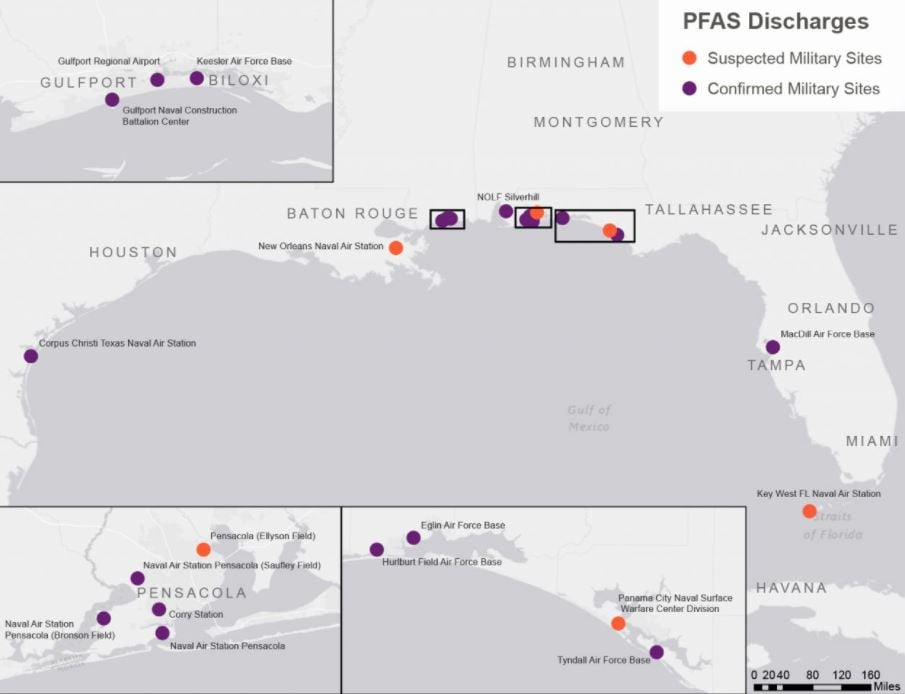High levels of toxic chemicals, known as “forever chemicals,” have been found in groundwater from at least 13 Department of Defense sites in the Gulf of Mexico.
According to Environmental Working Group (EWG), perfluoroalkyl and polyfluoroalkyl substances — known as PFAS — found in the groundwater adversely affect Gulf fish and residents who subsequently consume any contaminated seafood.
The 13 defense department sites that have had serious levels of PFAS contaminations detected are Silverhill Navy Outlying Field, Correy Station, Eglin Air Force Base (AFB), Hurlburt Field AFB, MacDill AFB, Naval Air Station (NAS) Pensacola, NAS Pensacola-Bronson Field, NAS Pensacola-Saufley Field, Tyndall AFB, Gulfport Naval Construction Battalion Center, Gulfport Regional Airport, Keesler AFB, and NAS Corpus Christi.
Reports cited by EWG show that the levels of PFAS contamination detected from these sites are hundreds of times higher than groundwater safety standards in states such as California and Vermont.

According to the Environmental Protection Agency (EPA), PFAS have been used in the United States since the 1940s, and there is evidence that exposure to PFAS can lead to adverse human health effects, although most studies have been conducted on animals.
Studies conducted on laboratory animals cited by the EPA have found that PFAS such as perfluorooctane sulfonic acid (PFOS) and perfluorooctanic acid (PFOA) can cause reproductive and developmental issues, tumors, negative effects on the immune system and liver and kidney diseases.
PFAS have been manufactured and used in a variety of industries around the globe. Everyday sources of PFAS include kitchenware and pizza boxes, and on DOD sites they are commonly found in firefighting foams.
While there are currently no federal regulations regarding standards of PFAS contamination in groundwater, President Joe Biden’s Environmental Justice Plan includes a pledge to establish “enforceable limits for PFAS in the Safe Drinking Water Act.”
These recent contamination discoveries underscore the need for a swift PFAS cleanup by the Department of Defense, Jared Hayes, a policy analyst at the Environmental Working Group, wrote in his recent report regarding DOD sites and PFAS contamination.
“Even at very low doses of PFAS in drinking water, our service members and their families are at risk of the suppression of their immune system and an elevated risk of cancer, increased cholesterol, and reproductive and developmental harms, among other serious health issues,” Hayes said in his analysis.
Although PFAS contamination in the Gulf is not solely the fault of defense department sites — contamination is suspected from hundreds of industrial sites throughout the region — recent DOD records show that levels of PFAS in groundwater from these 13 sites are reaching maximum detections ranging from 718 parts per trillion (ppt) to 877,000 ppt.
For context, states such as Michigan have set drinking water standards and groundwater cleanup criteria at 8 ppt for PFOA and 16 ppt for PFOS.
DOD assessments additionally show that PFAS may be present in the groundwater at several other Gulf sites. Results from detection tests have not been released for NAS Key West, Joint Reserve Base New Orleans, Panama City Naval Surface Warfare Center Division and NAS Pensacola-Ellyson Field.
Rachel is a Marine Corps veteran and a master's candidate at New York University's Business & Economic Reporting program.





